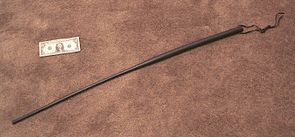Sjambok
| Sjambok | |
|---|---|
| Type | Whip |
| Place of origin | Africa |
| Specifications | |
| Length | 90 to 150 centimetres (35 to 59 in) |
The sjambok (IPA: [ˈʃæm.bʌk, -bɒk]) or litupa is a heavy leather whip. It is traditionally made from an adult hippopotamus (or rhinoceros) hide, but is also commonly made out of plastic.
A strip of the animal's hide is cut and carved into a strip 0.9 to 1.5 metres (3 to 5 ft) long, tapering from about 25 mm (1 in) thick at the handle to about 10 mm (3⁄8 in) at the tip. This strip is then rolled until reaching a tapered-cylindrical form. The resulting whip is both flexible and durable. A plastic version was made for the South African Police Service, and effectively used for riot control.
The sjambok had a variety of uses, with the most obvious being cattle driving. It was heavily used by the Voortrekkers driving their oxen while migrating from the Cape of Good Hope. Even today, the sjambok is used by herdsmen to drive cattle. They are widely available in South Africa from informal traders to regular stores from a variety of materials, lengths and thicknesses. They are an effective weapon to kill snakes and ward off dogs and other attackers and are still carried in public by many black South Africans for self-defense. Many South African households keep a sjambok.
In South Africa it is sometimes seen as synonymous with the apartheid era, but its use on people started much earlier. It is sometimes used outside the official judiciary by those who mete out discipline imposed by extralegal courts.
In 1963, an enquiry into the police force of Sheffield in the United Kingdom found that rhino whips had been used on suspects to produce confessions where there was no apparent evidence to link them to the crimes.
The name seems to have originated as cambuk in Indonesia, where it was the name of a wooden rod for punishing slaves, where it was possibly derived from the Persian chabouk or chabuk. When Malayan slaves arrived in South Africa in the 1800s, the instrument and its name were imported with them, the material was changed to hide, and the name was finally incorporated into Afrikaans, spelled as sambok.
...
Wikipedia

